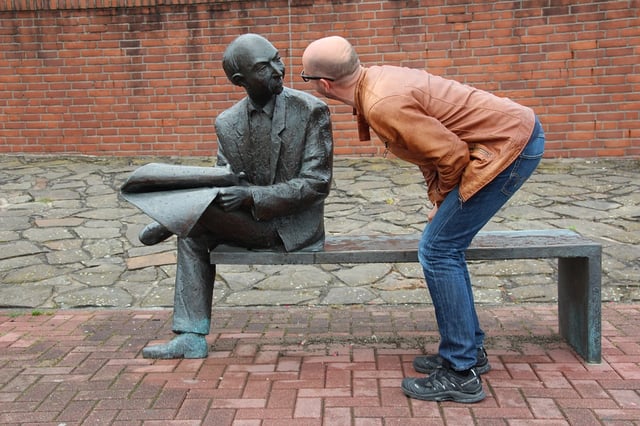
Have you been taking the wrong approach to public speaking? To succeed with audiences, learn this amazing technique concerning how to prepare a speech.
When you deliver a speech or presentation, you want to provide listeners with important information while being recognized as a competent speaker.
So shouldn't you be focused on giving a good performance?
Unfortunately, we all live too much in an analytical world of notes, manuscripts, bullet points, charts, graphs, numbers, experimental results, and whatever other data our particular industry swears by. We're settled and proficient in this world because we've been trained for it. And when it comes time to get it all across to others, we often make a fundamental mistake.
Do you want your messages to resonate with listeners and move them to action? Then you should know the elements of effective presentations. Learn what they are in my free presenter's guide, "7 Key Components of Successful Presentations."
We fall under the spell of our own analysis, believing that the data are the influencers in the room. But of course that is exactly the opposite of the whole idea of public speaking. There is only one true conjurer in this situation—the one who can create magic on stage. And this magician doesn't exist on a screen or notes on a lectern.

Why You're the Heart and Soul of Your Speech
The magician, of course, is you. Only you can bring your data literally to life, so it exists in the human terms your audience needs to be able to truly understand it.
And I'm not being metaphorical when I say 'magic' and 'magician.' The famous nineteenth century actor Edmund Kean had this said about him by the equally famous English poet, critic, and philosopher Samuel Taylor Coleridge:
"To see him act, is like reading Shakespeare by flashes of lightning."
We don't know whether Coleridge meant that Kean was simply electrifying, or that he revealed flashes of brilliance in between scenes filled with ordinary acting. Either way, when Kean was on stage there must have been magic in the air. And as humble as our own everyday speeches and presentations may be, we are the heirs of Kean's performances—because in that word 'performance' is the essence of what public speaking both aims for and achieves.
Speaking is a live event—a form of community—in which you as speaker literally embody the text. You are the living, breathing personification of the ideas you're expressing. In a sense, you give life to dead material. Your job is to animate the deadness of data, the lifelessness of it. The magnitude of what you’re saying gives your talk size. But it only comes to life in your body and your voice, and through you in the mind and hearts of your listeners.
This may be a mind-altering recognition of your job on stage, yet it is at the core of the performative situation we call public speaking. Speaking to audiences is truly a transformative event, because it won't succeed unless you can first transform your material into a conversation with listeners. The good news is that this is the perfectly predictable result of you wanting to get something across to people interested in hearing it. Once you're in the right frame of mind, it should happen naturally without much heavy lifting on your part. But it's important for you to remember that you're going beyond thought into the realm of an experience with those listeners. The wonderful part about all of this is that it starts with a simple conversation.

Do You Make Your Audience Comfortable?
Despite the serious business of giving dry pulseless data a beating heart, you're lucky in the sense that public speaking these days is more relaxed and natural than it's ever been. Gone are the days when orators poked holes in the air with their index finger, and each emotion was assigned a pose on the stage. What changed all that? The flat screen in your living room.
As Roger Ailes told us in his influential book You Are the Message, "television changed the rules":
As a result of TV, people today expect to be made comfortable in every communications situation. When someone speaks to them, they want to relax and listen just as they do when a TV professional entertains them in their living room. . . . The style that’s acceptable on television—relaxed, informal, crisp, and entertaining—has become the modern standard for an effective communicator.[1]
Added to this is the fact that TV eliminates distance. A speaker at a far-away podium is a very different proposition from the television personality who talks to you from just feet away, right there in your home!
These days, no matter how weighty your topic you must be conversational. Your challenge, then, is to translate your intellectual data into the style, forms, sounds, and rhythms of speech. Here's how to do it.

Know Which Arena You're Stepping Into
You take a big step—an ontological leap, really—when you go from the literary, financial, medical, scientific, regulatory, etc. world of your notes and enter what I call the 'oral arena." Performance is your greatest friend in this domain; so you need to become practical and proficient at building and carrying out a spoken performance.
That's why I suggest you take the radical step of rearranging how you put together a speech. Specifically, I want you to start speaking out loud much earlier in your preparation regimen than you're used to. My reasoning is simple yet inescapable: If you're going to give a speech, put your ideas together as early as possible in the form in which the audience will hear them.
Consider, for instance, how you've been assembling presentations up until now. Hasn't it involved these steps?
- Think
- Write (and then edit and polish)
- Speak (i.e., rehearse)
But there's something wrong with that order of events. When you (at last) get to the point where you practice on your feet, what you hear as you speak your words may not sound right. That's because there's a vast difference between what we 'hear' in our minds as we read a manuscript or notes, and what sounds appropriate when spoken aloud. Only at this last moment in your process of building a speech may you discover that you have to go back and re-write some of what you've worked so hard to perfect. Your polished literary document falls flat on the ear.
The reality is, you yourself don’t fully appreciate the meaning of the text until you speak it. That is when your own emotional connection to the meaning, through the breath you use to express that meaning, becomes clear.
With that in mind, remember this essential truth about public speaking:
Your performance actually begins the moment when you start to take notes for your speech.
What you're listening for when you give the material voice is tone, an appropriate level of knowledge for this audience, the precision of the words you want to use, the vividness and impact of your statements, whether you're telling stories as well as delivering data—and all the other elements that need to gel when your talk goes from the page to the stage. Your preparation, then, should look like this:
- Think
- Speak out loud (listening for all of the above)
- Write it down
By the time you finish this process, your speech will be at least 50% complete without requiring too many rewrites. You'll save yourself a vast amount of time by avoiding going over the same material twice. And you'll have a speech that sounds just right for the ears of this audience.
That's how to prepare a speech.
[1] Roger Ailes, You Are the Message (New York: Doubleday, 1988), 15.
You should follow me on Twitter here.



